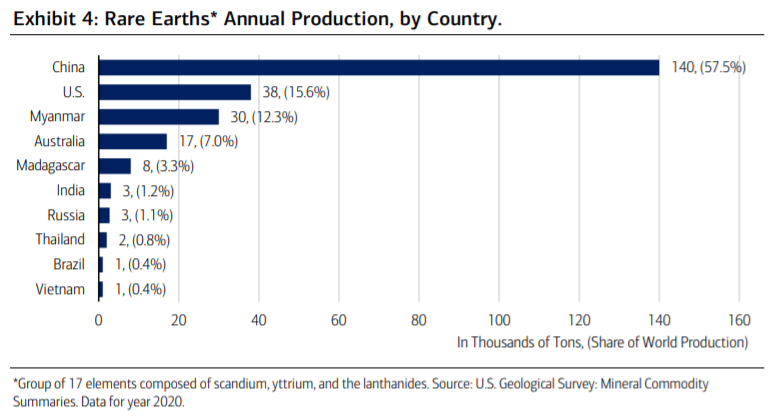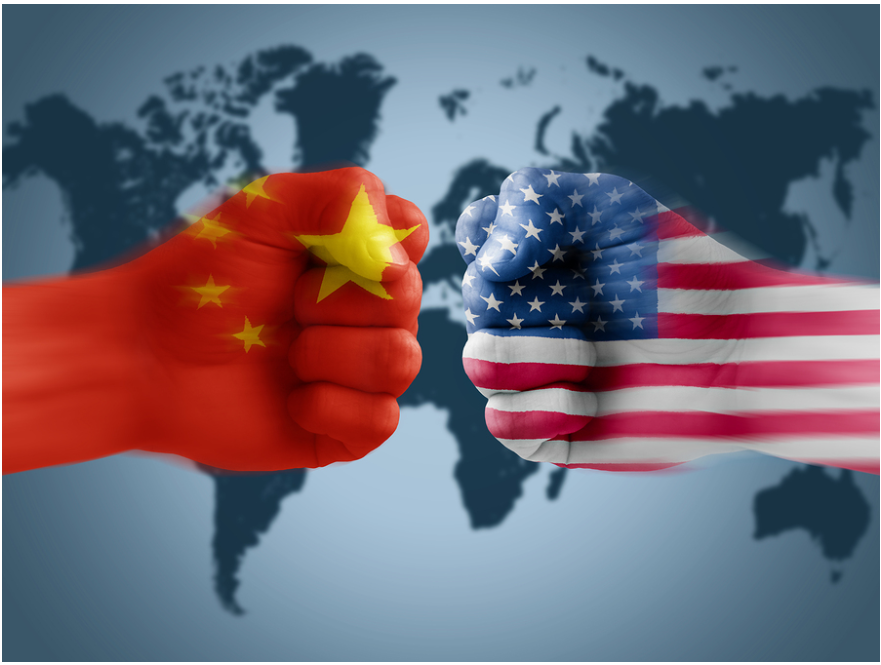USA og Kina er i en drabelig geopolitisk kamp, hvor USA forsøger at hindre en kinesisk dominans inden for en række af fremtidens erhverv og teknologier. I dag dominerer Kina f.eks. inden for batterier og sjældne jordarter samt på en række produkter i pharma-industrien. Men også chip-produktionen kommer i centrum. USA foretager en oprustning inden for disse erhverv med enorm statsstøtte, og det kan investorerne få gavn af, hvis de hopper med på bølgen, mener Merrill Lynch, der peger på følgende sektorer, som USA satser voldsomt på: materials, metals and mining, machinery, power generation, software and services, chipmakers, semiconductor, capital equipment, and hardware applications such as networking and cloud servers.
The Flashpoint for U.S. Supply Chains
Trade wars, weather interruptions, and supply/demand imbalances have weighed on supply
chain production of everything from cars and chips to siding and furniture. In this way, the
pandemic disruption to supply chains has served as a flashpoint in evaluating
vulnerabilities and fragilities across a number of industries.
As outlined by a recent White House report reviewing critical segments, more secure and resilient supply chains are essential in insulating the U.S. economy, national security, and future technological
leadership.1 While the implications of the report are mostly industrial and innovation policy
recommendations, from an investment standpoint this policy backdrop is supportive of
CapEx and R&D cycles, which reinforces our view on cyclical assets and longer-term
investments in tech-related industries.
The four industries of focus are: first, semiconductor manufacturing and advanced
packaging; second, large capacity batteries; third, critical minerals and materials; and
fourth, pharmaceuticals and advanced pharmaceutical ingredients.
Semiconductor manufacturing and advanced packaging: Although tiny chips,
semiconductors are essential components enabling technologies across the
telecommunications, industrial and automotive sectors, with Exhibit 2 showing the end
uses of chips. When it comes to production of semiconductors, the U.S.’s share of global
production has dropped to 12% from a 37% share in 1990. Capacity and production of
chips has grown outside of the U.S., particularly in Asia, leading the Semiconductor
Industry Association to forecast that by 2030 the U.S.’s share will fall to 10%, with Asia
responsible for 83% of global production. Highlighting the U.S.’s foreign dependence, the
U.S. relies on sales to China, the largest market for semiconductors, and is heavily
dependent on foreign sourcing for materials like silicon wafers from Japan, South Korea or
Taiwan.
Large Capacity Batteries: High-capacity batteries such as those used in electric vehicles
(EVs) and energy grid storage are critical to our country’s interest in “cleaner” and
“greener” technologies. EV battery demand is projected to grow from approximately 747
gigawatt hours (GWh) in 2020 to 2,492 GWh globally by 2025. China has a commanding
position across the battery value chain, from raw and processed materials to components
and assembly (Exhibit 3). China refines 60% of the world’s lithium and 80% of the world’s
cobalt, two core inputs to high-capacity batteries and key to the future auto industry.

Critical minerals and materials: Related, rare earths elements, critical in manufacturing
most technologies from electronics to fighter jets to weaponry, is controlled by China with
its willingness to mine (57% of global capacity) and refine (85% of global capacity) these
dirty, yet inherently not so rare, elements. The U.S.’s net import reliance has grown
alongside falling production since the Cold War. Exhibit 4 shows the distribution of rare
earth minerals worldwide.
Pharmaceuticals and advanced pharmaceutical ingredients: The pandemic fueled
concerns of “medical protectionism” or hoarding medical supplies for a country’s benefit
by curbing exports. The U.S. is among the largest net importers of medical goods and
equipment—a byproduct of decades of significant cost savings in a “globalizing” world.
China and India became major sources for the active ingredients for drugs beginning in
the 1970s. Exhibit 5 shows China’s control of the U.S.’s drug supply chain. India, which
supplies 40% of generic pharmaceuticals used in the U.S., imports nearly 70% of its active
pharmaceutical ingredients (APIs) from China. Thus, China’s overwhelming control of the
medical supply chain is likely underrepresented in the exhibit.

Source: U.S. Commerce Department. Data as of 2020.
A wide-ranging policy suggestion for the above: Invest in domestic production and
innovation capabilities while diversifying sources of supply and reducing concentrated
geographic risk. The commonality among the four areas is the apparent U.S. and China
linkages, which is why the premium on a CapEx cycle, underway since last year, and R&D
cycle has never been greater. Given the policy intentions of the report, a number of
catalysts underpin these cycles: nations favoring self-sufficiency in the production of
critical goods; the accelerating race for technological leadership in various industries; and
Investment Implications
Investors should consider positioning portfolios toward sectors that stand to benefit from
these cyclical and secular dynamics. With the potential of a federal infrastructure package,
capital equipment and industrial goods-related stocks could profit, including industries
such as materials, metals and mining, machinery, and power generation. We maintain our
positive long-term outlook on Technology due to a secular rise in spending on innovation
and competitiveness and the continued digitalization of the economy. Pandemic-driven
shifts in global supply chains could also boost demand for industrial automation and its
related investments. With policy and public investment serving as tailwinds (Chips for
America Act, which would provide $23 billion to domestic production of semiconductors),
long-term growth opportunities such as software and services, chipmakers, semiconductor
capital equipment, and hardware applications such as networking and cloud servers exist
within Technology.




